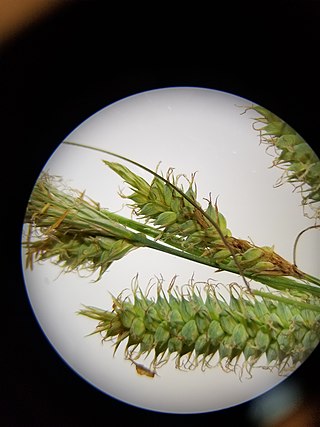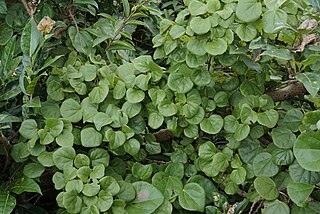Sycamore is a name which has been applied to several types of trees, but with somewhat similar leaf forms. The name derives from the ancient Greek συκόμορος (sūkomoros) meaning "fig-mulberry".

Alchemilla is a genus of herbaceous perennial plants in the family Rosaceae, with the common name lady's mantle applied generically as well as specifically to Alchemilla mollis when referred to as a garden plant. The plant used as a herbal tea or for medicinal usage such as gynaecological disorders is Alchemilla xanthochlora or in Middle Europe the so-called common lady's mantle Alchemilla vulgaris. There are about 700 species, the majority native to cool temperate and subarctic regions of Europe and Asia, with a few species native to the mountains of Africa and the Americas.
Gonystylus is a southeast Asian genus of about 30 species of hardwood trees also known as ramin, melawis (Malay) and ramin telur (Sarawak).

Menispermaceae is a family of flowering plants. The alkaloid tubocurarine, a neuromuscular blocker and the active ingredient in the 'tube curare' form of the dart poison curare, is derived from the South American liana Chondrodendron tomentosum. Several other South American genera belonging to the family have been used to prepare the 'pot' and 'calabash' forms of curare. The family contains 78 genera with some 440 species, which are distributed throughout low-lying tropical areas with some species present in temperate and arid regions.

Carpobrotus, commonly known as pigface, ice plant, sour fig, Hottentot fig, and clawberry is a genus of ground-creeping plants with succulent leaves and large daisy-like flowers. The name comes from the Ancient Greek karpos "fruit" and brotos "edible", referring to its edible fruits.
Ulmus glaucescensFranch., the Gansu elm, is a small deciduous tree from the northern provinces of China, where it is found along river valleys and on mountain slopes at elevations of 2000–2600 m.

Daphniphyllum is the sole genus in the flowering plant family Daphniphyllaceae and was described as a genus in 1826. The genus includes evergreen shrubs and trees mainly native to east and southeast Asia, but also found in the Indian Subcontinent and New Guinea.
Ulmus glaucescens var. lasiocarpaRehder, named the hairy-fruited glaucescent elm in the United States, is a Chinese tree found along rivers and mountain slopes at elevations of 2500–2600 m in the provinces of Hebei, Henan, Liaoning, Nei Mongol, Ningxia, eastern Qinghai, and Shanxi.
Glaucous is used to describe the pale grey or bluish-green appearance of the surfaces of some plants, as well as in the names of birds, such as the glaucous gull, glaucous-winged gull, glaucous macaw, and glaucous tanager.

Ferocactus glaucescens, the glaucous barrel cactus, is a species of flowering plant in the family Cactaceae, native endemic to México.

Carpobrotus glaucescens, commonly known as pigface or iceplant, is a species of flowering plant in the family Aizoaceae and is endemic to eastern Australia. It is a succulent, prostrate plant with stems up to 2 m long, glaucous leaves, daisy-like flowers with 100 to 150 light purple to deep pinkish-purple, petal-like staminodes and red to purple fruit. The fruits ripen mainly in Summer and Autumn. It usually only grows very close to the sea.

Cryptocarya glaucescens, commonly known as jackwood, is a rainforest tree of the laurel family growing in eastern Australia.

Sidalcea glaucescens is a species of flowering plant in the mallow family known by the common name waxy checkerbloom.

Persoonia glaucescens, commonly known as the Mittagong geebung, is a species of flowering plant in the family Proteaceae and is endemic to New South Wales. It is an erect shrub with smooth bark, hairy young branchlets, lance-shaped leaves with the narrower end towards the base, and yellow flowers. It is the only persoonia in eastern Australia with strongly glaucous leaves.
Eucephalus glaucescens is a North American species of flowering plant in the family Asteraceae known by the common name Klickitat aster. It grows on rocky slopes and in subalpine meadows at high elevations on and near Mount Adams in the south-central part of the US State of Washington.

Iris glaucescens is a plant species in the genus Iris and subgenus Iris. It is a rhizomatous perennial, found in Russia, Kazakhstan, Mongolia and China. It has blue-grey sickle-shaped leaves, slender stem, and spring flowers in blue-violet, pale violet, lilac-purple, to deep purple, to light bluish, and almost white shades. It is rarely cultivated as an ornamental plant in temperate regions. It was merged with another similar iris in the region, and became a synonym of Iris scariosa, before being divided into two separate species again, although some sources still call it a synonym of Iris scariosa.
Excoecaria glaucescens is a species of flowering plant in the family Euphorbiaceae. It was described in 1891. It is native to Madagascar.

Carex glaucescens is a perennial sedge that belongs to the family Cyperaceae. The common name of this sedge is the southern waxy sedge due to the blue-grey, waxy appearance of the sheaths and fruits. The term "glaucous" means "gleaming" or "grey" in Latin; the specific epithet of C. glaucescens is derived from this term. Carex glaucescens is a native plant in North America and is an obligate wetland species in the Atlantic and Gulf Coastal Plains, Eastern Mountains and Piedmont, and the Great Plains.

Diploclisia is a genus of flowering plants belonging to the family Menispermaceae.

Petrosimonia is a genus of flowering plants belonging to the family Amaranthaceae. It is also in the Salsoloideae tribe.













